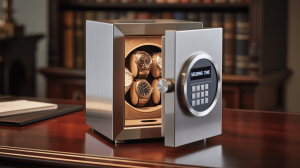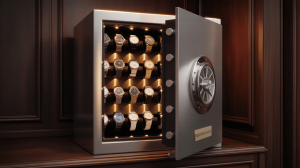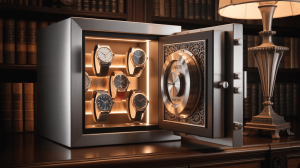Safe for Watches: Protecting Your Investment in Style. But here’s the kicker… Your luxury timepieces deserve storage that safeguards value while elevating your décor. A dedicated watch safe merges robust security, environmental control, and elegant design—perfect for discerning collectors.
1. Understanding the Need for a Watch Safe
Collectors often underestimate risks. Watches face threats from burglary, fire, humidity, and dust. A purpose‑built safe features reinforced steel walls, pry‑resistant doors, and precision locks—mechanical dials, electronic keypads, or biometric scanners—that block unauthorized access. Concealed anchor points allow secure bolting to floors or furniture, deterring removal. This layered protection preserves both function and resale value of your prized pieces.
| Security Element | Specification | Benefit |
|---|---|---|
| Steel Wall Thickness | 12–14 gauge steel | High tamper resistance |
| Locking Mechanism | Dial, keypad, biometric | Controlled, personalized access |
| Anchor Points | Floor/furniture mounting | Prevents theft by removal |
2. Assessing Burglary and Theft Protection
Review local crime statistics and insurance requirements. UL RSC or ETL burglary ratings guarantee forced‑entry resistance tested against drills and prying tools. Electronic locks with time‑delay features slow attempts further. Biometric scanners add fingerprint‑level authentication, ensuring only registered users gain entry. Tailor your safe’s rating to your risk profile and watch portfolio value.
3. Fire and Smoke Resistance Essentials
Fires can destroy movements and degrade lubricants within minutes. Seek UL 72 Class 350 ratings—30–60 minutes at 1,200–1,400 °F. Insulating materials like gypsum or ceramic composites inhibit heat transfer, keeping internal temps under 350 °F. Intumescent gaskets expand to seal door joints, blocking smoke ingress. Combining these features in a sleek profile ensures discreet yet effective fire protection.
4. Sizing Your Safe to Your Collection
Calculate current and future storage needs. Each watch on a pillow requires roughly 1.5–2 inches of height and 2 inches of width. Add compartments for straps, tools, and warranty paperwork. Compact safes (6×8×6 inches) hold 2–4 watches; medium (8×10×8) fits 4–6; large (10×12×8) stores 6–10. A snug interior prevents movement during opening and closing.
| Dimensions (W×D×H) | Watch Capacity | Extra Storage |
|---|---|---|
| 6×8×6 in | 2–4 | Minimal tools/straps |
| 8×10×8 in | 4–6 | Straps, small tools |
| 10×12×8 in | 6–10 | Full kits and documents |
5. Selecting Exterior Finishes and Materials
The safe’s exterior should reflect your style. Matte powder‑coat steel offers stealth; brushed stainless appeals to modern aesthetics; wood veneer or leather wraps lend warmth. Ensure finishes resist scratches and corrosion, especially in humid environments, to maintain both look and longevity.
6. Lock Mechanism Options Explained
Mechanical wheels never fail due to power loss, though slower to operate. Electronic keypads allow multiple codes, time delays, and audit logs. Biometric scanners offer quick fingerprint access but require periodic re‑enrollment. Dual‑lock setups combine methods—such as keypad plus key—to create layered security ideal for high‑value collections.
7. Integrating Watch Winder Functionality
Automatic watches need motion to stay accurate. Built‑in winders with adjustable turns‑per‑day (TPD) and rotation directions (CW, CCW, bi‑directional) match manufacturer specifications. High‑quality, low‑vibration motors (< 25 dB) ensure quiet operation. Removable winder trays convert to static storage, providing maximum versatility.
| Winder Feature | Specification | Benefit |
|---|---|---|
| Adjustable TPD | 650–2,000 turns/day | Prevents over‑ or under‑winding |
| Direction Control | CW, CCW, bi‑directional | Matches each watch’s needs |
| Noise Level | Under 25 dB | Silent home or office environment |
8. Organizing the Interior for Protection
Interior organization prevents scratches and tangling. Use foam or velvet‑lined pillows for each watch. Adjustable trays let you customize spacing for varied case sizes. Hidden pockets beneath trays store straps, spring bars, and cleaning tools out of sight, yet within easy reach.
9. Climate and Humidity Management
Leather straps and metal movements require stable humidity. Door gaskets rated IP54 block dust and light moisture. Desiccant packets or integrated silica gel chambers maintain relative humidity below 50%. Digital hygrometers display real‑time moisture levels, while active dehumidifier modules provide precision control in humid climates.
10. Convenience of Access and Backup Solutions
Frequent use demands swift entry. Electronic keypads and biometric scanners offer instant access. Time‑delay settings deter brute‑force attempts. Always include a manual override—hidden mechanical keys or dials—for emergencies when power fails or codes are forgotten.
| Access Method | Speed | Reliability |
|---|---|---|
| Electronic Keypad | Fast | Requires power backup |
| Biometric Scanner | Instant | Needs periodic re‑enrollment |
| Mechanical Dial | Manual | Always functional |
11. Noise and Vibration Considerations
Watch winders and locking bolts can generate noise. Look for vibration‑dampened motor mounts and precision‑engineered locks keeping noise under 25 dB. Soft‑close hinges prevent door slams. In bedrooms or quiet offices, these silent features maintain peace.
12. Smart Connectivity and Monitoring
Modern safes connect via Bluetooth or Wi‑Fi for tamper, door‑open, and low‑battery notifications. Mobile apps allow remote lock/unlock, TPD adjustments, and audit-log reviews—delivering peace of mind from anywhere.
| Smart Feature | Functionality | Advantage |
|---|---|---|
| Tamper Alerts | Real‑time notifications | Immediate awareness |
| Remote Control | App‑based lock/unlock | Convenience |
| Audit Logs | Records access attempts | Tracks user activity |
13. Power and Backup Power Options
Electronic locks and winders need reliable energy. Choose safes with dual‑power support—AC adapters for daily use and rechargeable battery packs for backup. Low‑battery alerts via LED or app prevent unexpected shutdowns. Always keep a hidden override key for emergencies.
14. Matching Décor and Style
Your watch safe should complement its surroundings. Slim profiles fit nightstands or shelving units. Matte, gloss, or veneer finishes blend seamlessly. Custom color or engraving options allow you to personalize the safe as a decorative focal point.
15. Budgeting for Value and Longevity
Safes range from entry‑level ($100–$300) with basic steel shells and key locks to premium models ($700+) featuring fire ratings, biometry, smart connectivity, and luxury finishes. Prioritize certifications, interior needs, and long‑term support over superficial extras.
Conclusion
A watch safe that combines security with elegance preserves your investment and enhances your décor. Ready for the good part? Use this guide to select a certified, feature‑rich safe that keeps your timepieces secure, climate‑controlled, and beautifully displayed.
FAQ
Q1: What burglary rating should I look for?
Aim for UL RSC or ETL certification to ensure forced‑entry resistance.
Q2: How often should I replace desiccant packs?
Replace every 6–12 months based on local humidity.
Q3: Are biometric locks reliable?
Yes—premium scanners include encrypted templates plus backup options.
Q4: Do smart features require subscriptions?
Basic app functionality is usually free; advanced monitoring may incur fees.
Q5: Is professional installation necessary?
DIY anchoring to studs or concrete can suffice—follow manufacturer guidelines.







